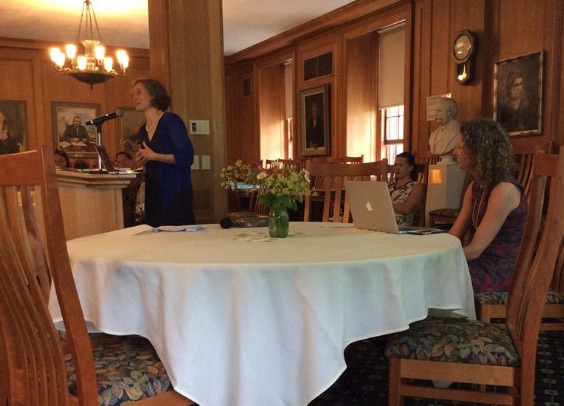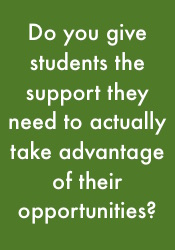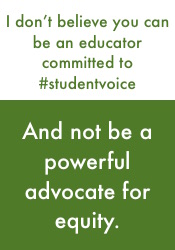“I don’t believe you can be an educator committed to student voice and not be a powerful advocate for equity.”
This past August, the University of Vermont played host to an international conference focused on ways to amplify student voice and increase student partnership in the classroom.
Attendees were lucky enough to hear an address by Vermont Secretary of Education Dr. Rebecca Holcombe, who spoke powerfully on the need for intersectional equity in Vermont, in supporting students.
Secretary Holcombe opened her remarks by recognizing the two student representatives to the VT State Board of Education, Rainbow Chen, from Winooski High School, and Connor Solimano, of Rutland High School, in Rutland, Vermont. Secretary Holcombe noted:
We have a state board of education which is tasked — and has real influence and power around legislative education issues in the state of Vermont — including drafting our education quality standards. And on that state board, we have two student members.
…Think about the commitment, to put a student at the heart, at the core of policy development.
You can listen to Secretary Holcombe’s full remarks on equity in Vermont, below.
(Editorial note: August in Vermont this year was boiling hot, so our chief audio engineer regrets that some amount of fan noise remains in the background of the speech. However, turning off those fans would likely have started a riot.)
“I don’t need to sell you on the importance of student voice and personalization, so I’m not going to.
But I am going to take this moment to talk about a few things that are really, really important to me, as you take on this work of student voice and personalization.
One of the things you may or may not know about my background is, I grew up in six different countries and four continents and I learned in seven different kinds of school contexts, including homeschool actually, for a period of about six months in Pakistan. And it is very hard to travel around the world, and travel around the United States and not learn some pretty powerful lessons about power and privilege. In particular, power, and the advantage that power can give when it’s associated with things like wealth, relative wealth, education, different levels of education, race, and gender.

We see that profoundly in the Vermont context as well.
It’s very easy to not remember that that has to be part of how we have this conversation. If we are truly committed to cultivating student voice, we have to acknowledge that there are many ways to be powerful and valued members of our civil society. And not all of them are ones that we might have chosen for ourselves.
If you think about our education force, our teachers are predominantly middle class, they’re predominantly women, and they’re predominantly white, in the state of Vermont.
- How are we going to recognize success?
- How are we going to gauge students who are different from ourselves?
- How do we create a system that supports personalization, but that is deeply respectful and supportive of the diversity of human experience and need for support?
That takes a certain amount of personal introspection and risk taking, and that is really, really hard work.
You are at the front of that.
You have to engage in that, or you are going to replicate some of the same problems that we have currently, in your new model of personalization. You have to be attentive to that.
Just be mindful as we talk about this — that giving voice is ceding authority: it means that you give up some of your authority so that somebody else can develop their own. It means not giving students the opportunity to just repeat independently what we would have assigned them to do anyways.
So first of all, we have to take seriously this whole project of equity, because there are some students — that represent a demographic that we’re not that successful with in the state of Vermont.
We need to remember that we have to be constantly asking ourselves,
“Is this really an opportunity that every one of our children can take advantage of?”
Because if we aren’t doing that in a very disciplined way, we are going to create systems that benefit some children more than others, because we don’t all come to the table with equal abilities to exercise voice.
There are several ways to think about equity — and I think this is a very helpful way to think about it — we can say that we open the door. We say that we have this opportunity, we have Act 77 and personalized learning, that’s available to everybody in the state as an entitlement…
But that’s not equity. It isn’t equity.
We can also say: we’ve opened this door, we’ve created this tool, and we want to make sure everybody’s represented at the table, including all these kids in our pathways, and so we’re going to track whether or not they’re participating in some kind of flexible pathway.
I would say, most work in Vermont is in one of these two phases, but the next phase is really the last one.
True equity to me, means saying: did you open the door and bring everybody in proportions relatively consistent with the representation population?

And did you give them the support they need to actually take advantage of those opportunities?
That — as a state — is where we need to do our next level of work. Because if we simply provide the opportunity, and say it’s up to you to get it, but don’t recognize that students living in serious adversity do not come to school with the same privileges and same advantages and actually can’t have success without additional support, we are replicating the same kind of tier system that we currently have, that serves some kids at the expense of other kids.
And our obligation as educators and as people who are committed to a civil society, is to make sure that we are rigorously taking that system apart.
To ensure that all student voice is at the table, not just the students who are better supported.
That’s really a core commitment of the VT Agency of Education, and it’s really important because we know in our own data that this is a real problem.
We know that this is happening, and it’s also important because we know from, for instance, the field of neuroscience, that the job of the educator is fundamentally different. We know that students’ ability is not fixed.
There was a study, that to me was one of the most compelling studies out there in the last couple years, by Elizabeth Sowell who is the Director of Development and Cognitive Neuroimaging at the Children’s Hospital in Los Angeles. And she studied brain surface area in children from different socioeconomic strata. And she found that the surface area of the brain of a child whose family makes less than $25,000 a year is about 6% smaller than that of a child whose family makes $150,00 per year. The difference was most traumatic for children at lowest socioeconomic levels. Wealthier children also performed better on tests of cognitive and executive functioning.
That surface area that she’s talking about is the surface area that controls a lot of the executive functioning which, frankly, is the basis of student voice.
If you can’t manage your own operations, you can’t exercise your voice.
We know that this study controlled meta-factors; there’s nothing wrong with the genes of children. The study hypothesized that the differences in brain surface area and functioning were a function of environmental factors. Like access to basic nutrition, access to health care, access to clean and safe areas to play, air quality, and rich, supportive, and responsive learning environments.
That’s on us. Think about the implications of that.
It’s our shame. It is our shame if we tolerate that kind inevitability, because quite literally:
The adults in a child’s life are the sculptors of their brain at the mechanical level.
So are the interactions we have, the supports we choose, or don’t choose to provide for our children.
When you interact with a child and you’re working on personalized learning, you are actually reshaping the basic architecture of their brain in ways that build their capabilities to interact effectively with others and exercise voice.
In consistent stress, you actually impede development at the neurological level, and that has profound implications for potential down the road. You are actually eroding the potential for student voice in some of our children.
This is also true — and a lot of people say that’s why we need early intervention — you need to know that this urgency is true at every single level.
There was another researcher named Sue Ramsden from the University College of London, who studied adolescence over four years of high school, and she found that this initial group who included a random sample, that included higher achieving and lower achieving, struggling students, she tested their IQs and analyzed their brains using MRI’s over a period of time, and three or four years later, and she found that the average of all scores stayed the same across all years. Kids ended up on average, with the same IQ after four years that they had at the beginning. However, individual IQ scores fell or rose by as much as 21 points.
Think about that. The individual change was huge.
That’s enough to make a difference between a child who is average and a child who is equal.
And here is what’s even more powerful: the brain scans that she showed, showed that the changes in IQ were mirrored by changes in the architecture of the brain.
The takeaway is that when children’s IQs go up it’s a signal of increased density of neurons and cells in associated parts of the brain, and when they go down, kids are losing that brain density. In other words, these changes reflect real changes in ability, not varying concentration.
It wasn’t that the kids weren’t paying attention. The brains of our children continue to be plastic far beyond the window that we used to think.
In other words, what you do, and the systems that you set up? Matter.
Because they actually determine whether your children can actually exercise voice. You are determining by the quality of the support you give your children, whether they will be able to realize their dreams.

And that is the most important responsibility I think any of us could ever have.
If we have gross, struggling neglect on certain children, that’s on us, that’s a cultural choice that we have made. And if we don’t like it then we have to say, “What are we doing to fix it?”
And I point that out because I don’t believe you can be an educator committed to student voice and not be a powerful advocate for equity.
So I hope that as part of this work, you will really think how you can advocate for equity and for support of children across a broad spectrum of needs. So that all of our children can come to the table and take advantage of these opportunities.
And then the last thing I would say is, we have to be very honest and very diligent about making sure when we provide these opportunities to kids, we are really focused on quality.
If you think about Gus, what was powerful about his experience was that we took a child who, by his own admission was headed out of school — and I don’t know if you caught it, but in his video, he’s talking about his profit and loss statements, his balance sheets, the financial forecasting he’s doing. He’s got a math model for how his herd is going to progress and develop. He’s doing an awful lot of math that he was not doing before.
And he is working with a math teacher to make sure he is learning at high levels.
There is no equity and there is no way out of poverty if you can’t read and write.
We know that the generation growing up is facing more adversity, and the achievement gaps are wider now than they’ve been in about forty or fifty years. There is less social mobility, and we know that problem is being aggravated.
We owe it to our kids: we have to make sure that the work we’re doing isn’t just about finding voice, but about finding opportunities to also challenge students responsibly, when they have not challenged themselves enough.
That’s what we have to do. That’s our commitment to our kids.
So that they are really graduating not just with a vision, but as we often say at the Agency, “with the wheels on the bus.” They can actually drive their vision, because we’ve equipped them with the skills and knowledge they need to be powerful players in their world.
I really think it’s important to remember that.
We know, in our own Vermont data, that we have many children who are leaving school without the skills they need to act on their vision. We cheat them. We cheat them when we do that.
Process without skills and knowledge is cheating the child, because we haven’t given them the means to get where they want to go. And the world, in so many ways, is biased toward people with skills in ways that we who have skills sometimes don’t acknowledge.
And we need to teach our kids that code. That’s our ethical responsibility as educators.


